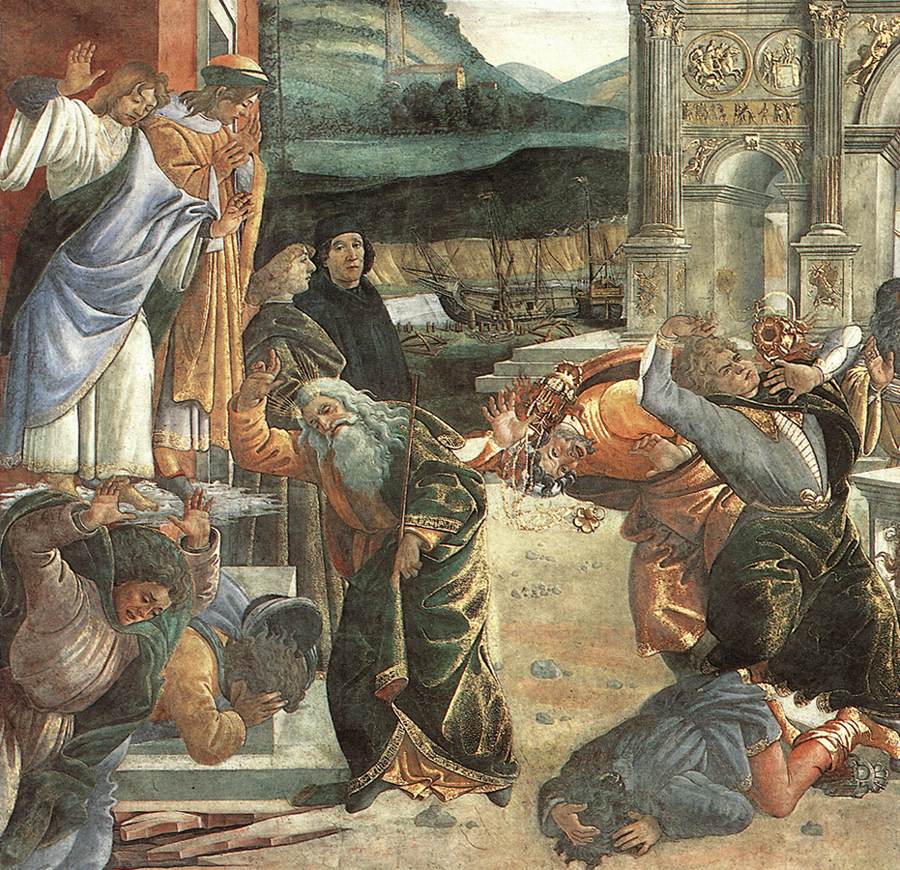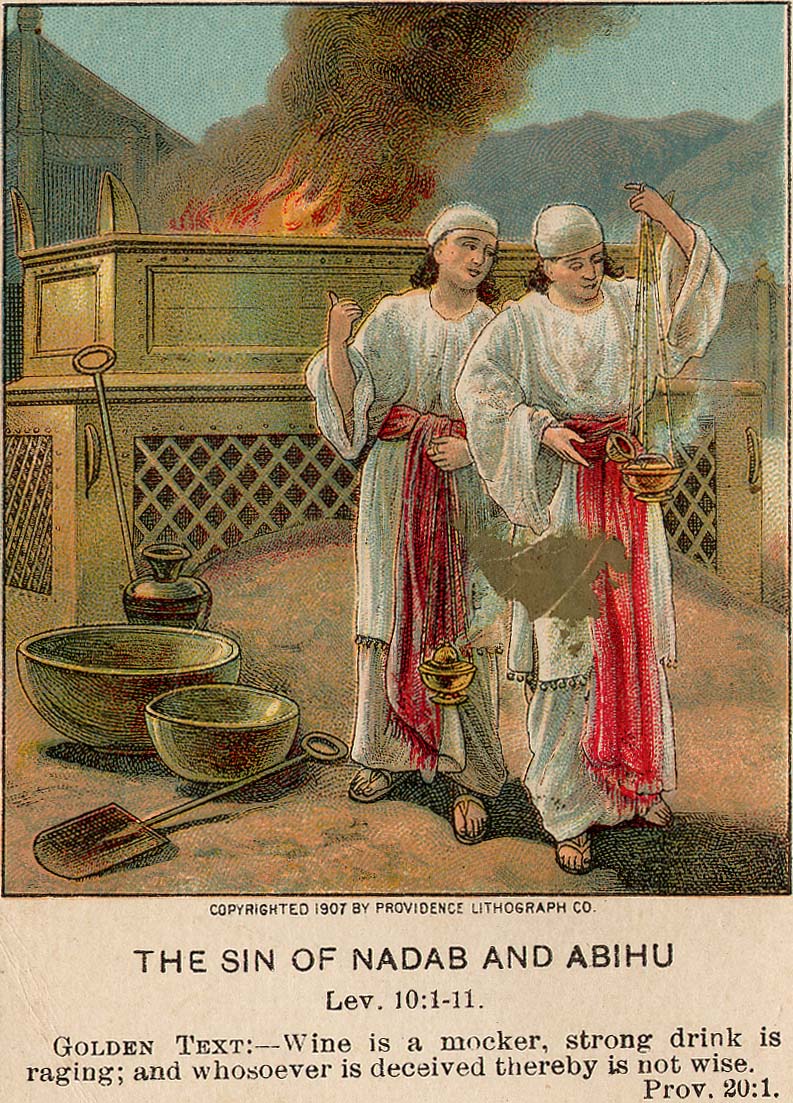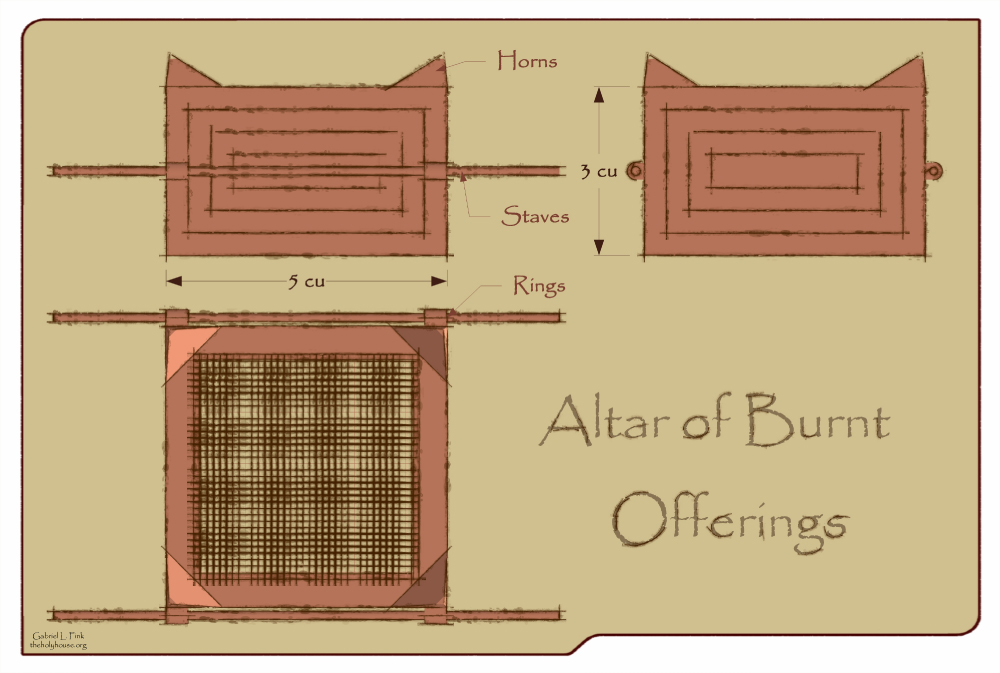|
Eleazar
Eleazar (; ) or Elʽazar was a priest in the Hebrew Bible, the second High Priest, succeeding his father Aaron after he died. He was a nephew of Moses. Biblical narrative Eleazar played a number of roles during the course of the Exodus, from creating the plating for the altar from the firepans of Korah's assembly, to performing the ritual of the red heifer. After the death of his older brothers Nadab and Abihu, he and his younger brother Ithamar were appointed to the charge of the sanctuary. His wife, a daughter of Putiel, bore him Phinehas, who would eventually succeed him as High Priest. Leviticus 10:16–18 records an incident when Moses was angry with Eleazar and Ithamar, for failing to eat a sin offering inside the Tabernacle in accordance with the regulations set out in the preceding chapters of Leviticus regarding the entitlement of the priests to a share of the offerings they made on behalf of the Israelite people. As the Israelites moved through the wilderness ... [...More Info...] [...Related Items...] OR: [Wikipedia] [Google] [Baidu] |
Aaron
According to Abrahamic religions, Aaron ''′aharon'', ar, هارون, Hārūn, Greek ( Septuagint): Ἀαρών; often called Aaron the priest ()., group="note" ( or ; ''’Ahărōn'') was a prophet, a high priest, and the elder brother of Moses. Knowledge of Aaron, along with his brother Moses, exclusively comes from religious texts, such as the Hebrew Bible, Bible and the Quran. The Hebrew Bible relates that, unlike Moses, who grew up in the Egyptian royal court, Aaron and his elder sister Miriam remained with their kinsmen in the eastern border-land of Egypt ( Goshen). When Moses first confronted the Egyptian king about the enslavement of the Israelites, Aaron served as his brother's spokesman ("prophet") to the Pharaoh (). Part of the Law given to Moses at Sinai granted Aaron the priesthood for himself and his male descendants, and he became the first High Priest of the Israelites. Aaron died before the Israelites crossed the Jordan river. According to the Boo ... [...More Info...] [...Related Items...] OR: [Wikipedia] [Google] [Baidu] |
Phinehas
According to the Hebrew Bible, Phinehas or Phineas (; , ''Phinees'', ) was a priest during the Israelites’ Exodus journey. The grandson of Aaron and son of Eleazar, the High Priests (), he distinguished himself as a youth at Shittim with his zeal against the heresy of Peor. Displeased with the immorality with which the Moabites and Midianites had successfully tempted the Israelites () to inter-marry and to worship Baal-peor, Phinehas personally executed an Israelite man and a Midianite woman while they were together in the man's tent, running a javelin or spear through the man and the belly of the woman, bringing to an end the plague sent by God to punish the Israelites for sexually intermingling with the Midianites. Phinehas is commended by God in Numbers 25:10-13, as well as King David in for having stopped Israel's fall into idolatrous practices brought in by Midianite women, as well as for stopping the desecration of God's sanctuary. After the entry to the land of I ... [...More Info...] [...Related Items...] OR: [Wikipedia] [Google] [Baidu] |
Ithamar
In the Torah, Ithamar () was the fourth (and the youngest) son of Aaron the High Priest."Ithamar", ''Encyclopaedia Biblica'' Following the construction of the Tabernacle, he was responsible for recording an inventory to ensure that the constructed Tabernacle and its contents conformed to the vision given by God to Moses on Mount Sinai. Kohen After the death of his two eldest brothers, Nadab and Abihu, when they had been punished by the Lord for performing an unauthorized incense offering, Ithamar served as a priest along with his elder brother, Eleazar, and Ithamar and Eleazar are regarded as the direct male ancestors of all Kohanim. records an incident when Moses was angry with Eleazar and Ithamar, for failing to eat a sin offering inside the Tabernacle in accordance with the regulations set out in the preceding chapters of Leviticus regarding the entitlement of the priests to a share of the offerings they made on behalf of the Israelite people. During the travels of the Isra ... [...More Info...] [...Related Items...] OR: [Wikipedia] [Google] [Baidu] |
High Priest Of Israel
High Priest ( he, כהן גדול, translit=Kohen Gadol or ; ) was the title of the chief religious official of Judaism from the early post-Exilic times until the destruction of the Second Temple in Jerusalem by the Romans in 70 CE. Previously, in the Israelite religion, including during the time of the kingdoms of Israel and Judah, other terms were used to designate the leading priests; however, as long as a king was in place, the supreme ecclesiastical authority lay with him. The official introduction of the term "high priest" went hand-in-hand with a greatly enhanced ritual and political significance bestowed upon the chief priest of the Israelites in the post-Exilic period, especially from 411 BCE onward due to the religious transformations brought about during the time of the Babylonian captivity and due to the lack of a Jewish king and kingdom. The high priests belonged to the Jewish priestly families that trace their paternal line back to Aaron—the first high pries ... [...More Info...] [...Related Items...] OR: [Wikipedia] [Google] [Baidu] |
Korach (parashah)
Korach or Korah ( he, קֹרַח ''Qoraḥ'' — the name " Korah," which in turn means ''baldness'', ''ice'', ''hail'', or ''frost'', the second word, and the first distinctive word, in the parashah) is the 38th weekly Torah portion (, ''parashah'') in the annual Jewish cycle of Torah reading and the fifth in the Book of Numbers. It tells of Korah's failed attempt to overthrow Moses. It comprises . The parashah is made up of 5,325 Hebrew letters, 1,409 Hebrew words, 95 verses, and 184 lines in a Torah Scroll (, ''Sefer Torah''). Jews generally read it in June or July. Readings In traditional Sabbath Torah reading, the parashah is divided into seven readings, or , '' aliyot''. First reading — Numbers 16:1–13 In the first reading (, ''aliyah''), the Levite Korah son of Izhar joined with the Reubenites Dathan and Abiram, sons of Eliab, and On, son of Peleth and 250 chieftains of the Israelite community to rise up against Moses. Korah and his band asked Moses and Aar ... [...More Info...] [...Related Items...] OR: [Wikipedia] [Google] [Baidu] |
Nadab And Abihu
In the biblical books Exodus, Leviticus and Numbers, Nadab () and Abihu () were the two oldest sons of Aaron. According to Leviticus 10, they offered a sacrifice with "foreign fire" before the , disobeying his instructions, and were immediately consumed by God's fire. Moses instructed Aaron and his family not to mourn, although the people at large were permitted. Background Nadab and Abihu were the first two sons of Aaron the Levite by his marriage to Elisheba, daughter of Amminadab from the tribe of Judah. They had four sons in total, the younger two sons being named Eleazar and Ithamar. During the Exodus journey, after the Israelites' affirmation of their covenant with God, Abihu and Nadab accompanied Moses, Aaron, and 70 elders up Mount Sinai. There they saw God with great clarity, walking on a pavement of sapphire stone, and shared a meal in God's presence, without being harmed as a result. Aaron and his four sons were the first priests appointed as the priestly sy ... [...More Info...] [...Related Items...] OR: [Wikipedia] [Google] [Baidu] |
Book Of Numbers
The book of Numbers (from Greek Ἀριθμοί, ''Arithmoi''; he, בְּמִדְבַּר, ''Bəmīḏbar'', "In the desert f) is the fourth book of the Hebrew Bible, and the fourth of five books of the Jewish Torah. The book has a long and complex history; its final form is possibly due to a Priestly redaction (i.e., editing) of a Yahwistic source made some time in the early Persian period (5th century BC). The name of the book comes from the two censuses taken of the Israelites. Numbers begins at Mount Sinai, where the Israelites have received their laws and covenant from God and God has taken up residence among them in the sanctuary. The task before them is to take possession of the Promised Land. The people are counted and preparations are made for resuming their march. The Israelites begin the journey, but they "grumble" at the hardships along the way, and about the authority of Moses and Aaron. For these acts, God destroys approximately 15,000 of them through vario ... [...More Info...] [...Related Items...] OR: [Wikipedia] [Google] [Baidu] |
Ark Of The Covenant
The Ark of the Covenant,; Ge'ez: also known as the Ark of the Testimony or the Ark of God, is an alleged artifact believed to be the most sacred relic of the Israelites, which is described as a wooden chest, covered in pure gold, with an elaborately designed lid called the mercy seat. According to the Book of Exodus, the Ark contained the two stone tablets of the Ten Commandments. According to the New Testament Book of Hebrews, it also contained Aaron's rod and a pot of manna. The biblical account relates that approximately one year after the Israelites' exodus from Egypt, the Ark was created according to the pattern given to Moses by God when the Israelites were encamped at the foot of Mount Sinai. Thereafter, the gold-plated acacia chest was carried by its staves by the Levites approximately 2,000 cubits (approximately ) in advance of the people when on the march. God spoke with Moses "from between the two cherubim" on the Ark's cover. Biblical account Cons ... [...More Info...] [...Related Items...] OR: [Wikipedia] [Google] [Baidu] |
Altar (Bible)
Altars ( he, מִזְבֵּחַ, ''mizbeaḥ'', "a place of slaughter or sacrifice") in the Hebrew Bible were typically made of earth () or unwrought stone (). Altars were generally erected in conspicuous places (; ; ; ; ). The first altar recorded in the Hebrew Bible is that erected by Noah (). Altars were erected by Abraham (; ; ;), by Isaac (), by Jacob (; ), by Moses (), and by Saul (1 Samuel 14:35). After the theophany on biblical Mount Sinai, in the Tabernacle–and afterwards in the Temple–only two altars are mentioned: the Altar of Burnt Offering, and the Altar of Incense. Altar of burnt offering The first altar was the Altar of Burnt Offering (''mizbeach ha'olah''; ), also called the Brasen Altar (), the Outer Altar (''mizbeach hachitzona''), the Earthen Altar (''mizbeach adamah''), the Great Altar (''mizbeach hagedola'') and the Table of the Lord (). This was the outdoor altar and stood in the Court of the Priests, between the Temple and the Court of Israel, and upon w ... [...More Info...] [...Related Items...] OR: [Wikipedia] [Google] [Baidu] |
Promptuarium Iconum Insigniorum
''Promptuarium Iconum Insigniorum'' (full title: ''Prima pars Promptuarii iconum insigniorum à seculo hominum, subiectis eorum vitis, per compendium ex probatissimis autoribus desumptis''; ) is an iconography book by Guillaume Rouillé. Its title means ‘Promptuary (Handbook) of the Images of the Renowned eople��. History It was published in Lyon, France, in 1553. The work includes portraits designed as medals, and brief biographies of many notable figures. Although Julian Sharman, author of ''The Library of Mary Queen of Scots'', judges the work to be "not one of much numismatic interest", he notes that, "This work has been pronounced to be one of the marvels of early wood-engraving." The book includes a total of 950 woodcut portraits. Many of the figures portrayed are of English origin. The images begin with Adam and Eve. In the preface, the publisher praises the work."''Abhandlungen Der Königlich Preussischen Akademie Der Wissenschaften, Philosophisch-Historische Classe.' ... [...More Info...] [...Related Items...] OR: [Wikipedia] [Google] [Baidu] |
Tabernacle
According to the Hebrew Bible, the tabernacle ( he, מִשְׁכַּן, mīškān, residence, dwelling place), also known as the Tent of the Congregation ( he, link=no, אֹהֶל מוֹעֵד, ’ōhel mō‘ēḏ, also Tent of Meeting, etc.), was the portable earthly dwelling place of Yahweh (the God of Israel) used by the Israelites from the Exodus until the conquest of Canaan. Moses was instructed at Mount Sinai to construct and transport the tabernacle with the Israelites on their journey through the wilderness and their subsequent conquest of the Promised Land. After 440 years, Solomon's Temple in Jerusalem superseded it as the dwelling-place of God. The main source describing the tabernacle is the biblical Book of Exodus, specifically Exodus 25–31 and 35–40. Those passages describe an inner sanctuary, the Holy of Holies, created by the veil suspended by four pillars. This sanctuary contained the Ark of the Covenant, with its cherubim-covered mercy seat. An outer san ... [...More Info...] [...Related Items...] OR: [Wikipedia] [Google] [Baidu] |
Tabernacle
According to the Hebrew Bible, the tabernacle ( he, מִשְׁכַּן, mīškān, residence, dwelling place), also known as the Tent of the Congregation ( he, link=no, אֹהֶל מוֹעֵד, ’ōhel mō‘ēḏ, also Tent of Meeting, etc.), was the portable earthly dwelling place of Yahweh (the God of Israel) used by the Israelites from the Exodus until the conquest of Canaan. Moses was instructed at Mount Sinai to construct and transport the tabernacle with the Israelites on their journey through the wilderness and their subsequent conquest of the Promised Land. After 440 years, Solomon's Temple in Jerusalem superseded it as the dwelling-place of God. The main source describing the tabernacle is the biblical Book of Exodus, specifically Exodus 25–31 and 35–40. Those passages describe an inner sanctuary, the Holy of Holies, created by the veil suspended by four pillars. This sanctuary contained the Ark of the Covenant, with its cherubim-covered mercy seat. An outer san ... [...More Info...] [...Related Items...] OR: [Wikipedia] [Google] [Baidu] |









_(14781191601).jpg)